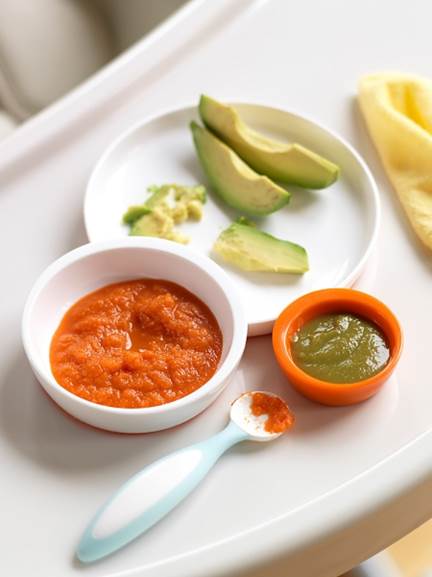When children start having weans, moms must
always wonder about which foods they should feed their babies. Nutritional
specialists will help mothers to make particular regimens for their
under-1-year-old children.
When should moms start weaning babies from
milk? What should babies eat? And, how much food is enough for babies for a
day? To answer those questions, specialists have made detailed regimens for
infants.
Children under 4 months old
Children’s
reaction
Their natural reaction at that time is
finding the nipples when their want to eat.
Foods
Breast milk or formula milk
Tips
Children digestive system is still under
developed, so foods aren’t appropriate to them; you should only let them have
breast milk or formula milk.

Children
under 4 years old should only have breast milk or formula milk.
Children from 4 to 6 years old
Children’s
reaction
Your children may not have all of the
followings reactions which are popular to children who start getting weaned
from milk.
·
Being able to put their heads up
·
Sitting in elbow chair
·
Start to chew
·
Having the weight doubled in comparison to the
moment they’re born
·
Being interested in foods
·
Being able to eat foods from spoons
·
Teething
Foods
·
Breast milk or formula milk
·
Pureed foods (sweet-potato, pumpkin, apple,
banana, peach or pear) or iron-fortified cereal
The daily amount of foods
When you start weaning babies, try with
about a teaspoon of pureed food or a spoon of a combination of cereal, breast
milk and formula milk twice a day. You can combine cereal with 4-5 teaspoons
(5ml) of well diluted breast milk or formula milk.
When children get used to foods, you can
feed them a spoon (15ml) of pureed food or a spoon of cereal and breast milk or
formula milk twice a day. If you choose cereal, you can reduce the level of
milk gradually.

Carrots
are good for children for starting weaning.
Children from 6 to 8 months old
Children’s
reaction
Similar to ones of children who are 4-6
months old
Foods
·
Breast milk or formula milk
·
Iron-fortified cereal (rice, barley and oats)
·
Pureed fruits or juice (banana, pear, apple,
peach)
·
Pureed vegetable or juice (avocado, cooked
carrot, pumpkin and sweet potato)
·
Pureed meat (poultry, pork, beef)
·
Pureed beans (black beans, green beans, soy,
lentil and red beans)
The
daily amount of food
·
3-9 spoon of cereal (15ml) 2-3 times a day
·
1 teaspoon (5ml) of fruit, increasing from ¼ to
½ a bowl (a bowl = 240ml). Feed 2-3 times a day.
·
1 teaspoon (5ml) of vegetable, increasing from ¼
to ½ a bowl. Feed 2-3 times a day.
Tips: you
should feed children a food continuously in at least 3 days before switching to
other fruits to know the food that you children are allergic to.

You should start feeding babies with a
small amount of pureed foods.
Children from 8-10 months old
Children’s
reaction
A part from ones that are similar to
children from 6-8 months old, they also have the following reactions:
·
Holding toys with thumbs and index fingers
·
They can change hands holding toys
·
Everything happening in the reach is put in
their mouth
·
Moving jaws as they are chewing something
Foods
·
Breast milk or formula milk
·
A small amount of pasteurized soft cheese,
yogurt, cheese (avoid having cow milk until they are 1 year old)
·
Pureed fruits and vegetables (banana, peach,
par, avocado, cooked carrot, pumpkin, potato, sweet-potato)
·
Foods that are possible for being held with
hands (crispy cookies dedicated for teething, low-sugar o-shaped cereals)
·
A small amount of protein (egg, pureed meat,
poultry, boneless fish, tofu, cooked pureed beans, pea, black beans)
The daily amount of food
·
¼ to 1/3 a bowl of milk
(a bowl = 240ml)
·
¼ to ½ a bowl of iron-fortified cereal
·
¼ to ½ a bowl of fruit
·
¼ to ½ a bowl of vegetable
·
1/8 to ¼ a bowl of protein products
Tips: you
should let children eat 1 food in succeeding 3 day at least before switching to
another to know in order to know which one your children allergic to.

Moms
should create suitable diets for children at each stage of ages.
Children from 10-12 months old
Children’s
reactions
A part from ones that similar to 8-10
months old, children also have the following signs
·
Swallowing foods more easily
·
Having more teeth
·
No longer spitting foods
Foods
·
Breast milk or formula milk
·
Pasteurized soft cheese, yogurt, cheese (avoid
feeding children cow milk until they’re 1 year old)
·
Iron-fortified cereal (rice, barley, oats, mixed
grain)
·
Chopped fruits or crushed potato
·
Chopped or well cooked vegetables (pea, carrot)
·
Protein (eggs, pureed meat, poultry and boneless
fish, tofu, cooked and crushed beans)
·
Foods that are able to be hold by hands (crispy cookies
dedicated for teething, low-sugar o-shaped cereal)
The daily amount of foods
·
1/3 a bowl of milk
·
¼ to ½ a bowl of iron-fortified cereal
·
¼ to ½ a bowl of fruit
·
¼ to ½ a bowl of vegetables
·
1/8 to ¼ a bowl of combined foods
·
1/8 to ¼ a bowl of protein foods
Tips: you
should let children eat 1 food in succeeding 3 day at least before switching to
another to know in order to know which one your children allergic to.